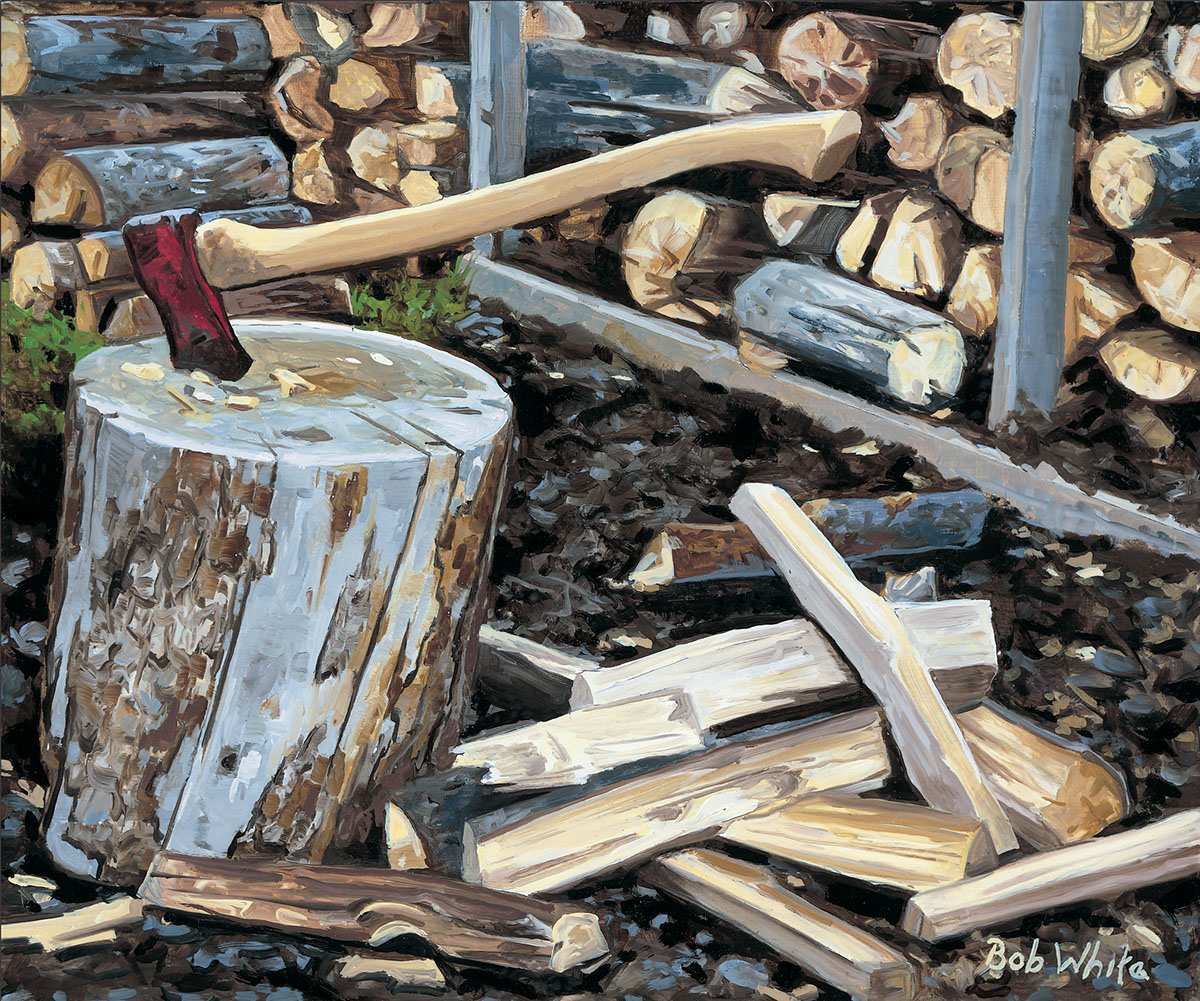
It was cold the other morning and I decided to warm the studio with the first fire of the season. With the realization that winter was on its way, I gauged the woodpile with a critical eye. We’ll burn three to four cords of hardwood through a severe winter, but since there’s softer wood mixed into the pile it may even stretch to five. As someone who heats with wood, I know that if we need five cords, I won’t rest easily until there’s at least eight or ten stacked and covered. To heat with wood teaches one about planning for the future, and I look upon the woodpile in much the same way as our retirement accounts; it’s better to end up with a little too much than not enough.
Ten cords of cut and stacked firewood represents a considerable investment of time and labor, but I don’t mind. I feel secure, even wealthy, when the chore is finished. Not that the work ends with the falling of the first snowflakes. Winter is the best time to cut and split wood for the following year. It’s a joy to work in the woodlot and not overheat, and even the toughest rounds seem to fairly explode beneath a maul when the temperature falls below zero.
To watch my father split cordwood, or “make wood” as he called it, is one of my fondest childhood memories, and as a boy I became enamored with the essential tools of a woodcutter. Though it takes more time and energy, I would prefer to use crosscut, buck, and bow saws. My idea of retirement is to have enough time to put away the noisy chainsaw with its tooth rattling vibrations and stifling exhaust. I’d like to smell the sweetness of hand-cut wood in my old age. In my mind, the perfect Christmas gift is a finely balanced Swedish splitting maul and a good pair of work gloves. “White Mule” brand, please.
Making wood is a great way to spend time with kids and teach them about life. It’s fun, and satisfying to work side-by-side with someone toward a common goal. I learned the value of hard work, and repeating a small task until the job is finished as I watched a woodpile grow. I don’t know of any studies to support the notion, but I suspect very few people who get into serious trouble have spent much time in a woodlot.
Some folks are particular about the wood they burn and prefer a homogenous woodpile. I like a mix of woods for the variety of scents they produce. Wood smoke is like a perfume to me and I appreciate a multiplicity of bouquets.
Oak and ash produce an aroma that I don’t easily tire of, and represent the foundation of my woodpile. Maple has a particularly rich tang that I enjoy in small doses. I love the pungent fragrance of birch on still, moonlit nights, and although I’ve never found any in Minnesota, the smoke from hickory has a way of taking me back to my youth and makes me nostalgic. Even softwoods that are often passed over by others will find a welcomed place in my woodpile. I treasure white cedar burnt on soft, gray autumn days, and save my meager supply of it for those special occasions. Willow, while low in BTU’s, produces a fragrant, sweet aroma that reminds me of the fires we kids made to warm our feet after a game of pond-hockey. A whiff of crackling spruce takes me back to the bonfires and shore lunches I’ve shared with friends.
Perhaps my fondness for wood smoke is why I prefer our ancient pot-bellied stove to the newer more efficient models; it leaks a rich and complex aroma that permeates everything in our workspace. Nearly everyone that visits the studio comments about how pleasant it smells. Even our dog, which spends an inordinate amount of time lying on the floor there, smells good.
I believe that how a woodpile is constructed reveals a lot about a person’s character. While there are many ways to go about it, properly stacked piles of wood have several things in common; the wood is raised off of the ground, it’s put up in such a way as to make its deconstruction convenient and efficient, and it’s protected from the weather. There are any number of contrivances for holding up a wall of wood; racks, steel fence posts, standing trees, expensive sheds, etc., but the experienced wood cutter has mastered the art of the self-standing wood pile. This is done with the skill of a master stonemason, and the pile leans back on itself ever so slightly.
Good kindling is highly valued by every wood-burner, for even seasoned wood that’s been properly stored needs to be started. Last summer I rebuilt the back porch on our old home, and in the process removed three layers of shingles. The original roof was made from first growth white cedar, so finely cut and seasoned that I can light a stick of it with a single match. Though I have no way to substantiate it, I’d like to believe that the trees came from the valley where we live, and were milled in our little village. What a find! There’s a peculiar essence to first growth white cedar, and I’ve decided that it smells of time.
Even something as simple as wooden, ‘strike anywhere’ matches takes on special meaning to someone who burns wood, and I have my preferences. Ohio Blue Tips are my favorite brand, and whenever I find them I’ll buy as many boxes as I can.
Not all the wood we make goes into the studio’s stove. Now that winter is close, and the nights have grown cold, it’s time to blend the rich scent of wood smoke with the sparkling stars, a haloed moon, and a bottle of cider from the cellar. Perhaps we’ll have a bon fire tonight.
And, as our five-year-old daughter, Tommy, stares into the flames I’ll ask her, “Have you ever thought about what we really see when we watch a fire?” And then, as it’s become a habit to answer my own questions, I’ll begin to tell her.





